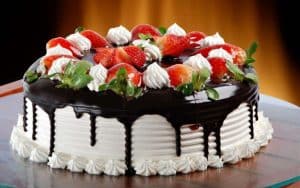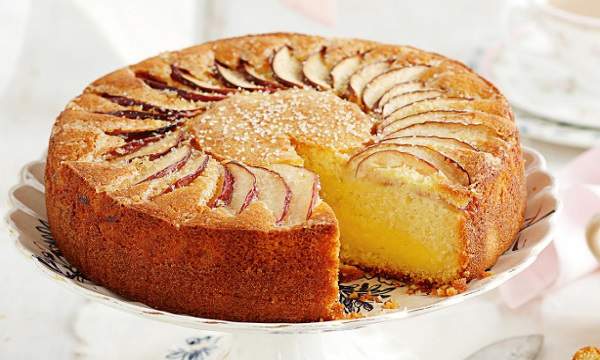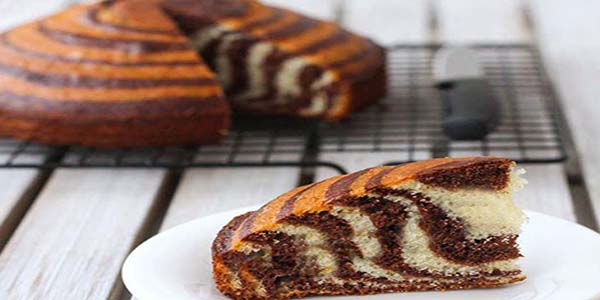- Liquids have not been carefully measured. (The amount of fluid used is low or high)
- The amount of mixing material is low or much more than usual.
- The temperature of the oven has been very low or very high.
- When mixing materials, the order of adding them is not observed.
- The butter or egg used is very cool.
- Bucking powder has been used less or too old.
- The amount of oil used is very high.
- The size of the mold is relative to the size of the cake.
- A long interval has been given before the cake mix is ready in the oven.

The cake is sticky:
- The cake has been covered over while warm.
- The amount of fluid used in the cake has been high.
- The cake is not cooked enough (it can be due to a short cook time or low temperature of the oven)
The cake has a wet state:
- The cake has been completely out of the oven before baking.
- The cake is not timely removed from the mold and cooled into the mold.
- The ratio of materials used is not right, so much sugar, fluids and fat can cause this condition.
The cake has several large holes and pockets:
- The temperature of the furnace has been very high.
- Raw materials not sufficiently mixed. (Low and high mixing both causes this condition)
- The amount of baking powder used was high.
Cake has a wrinkled look:
- The mold is great compared to the cake material.
- The template is too greasy.
- The material is too blended.
- The amount of fluids has been high.
- The cake is cooked too much (due to the high temperature of the oven or the length of cook time). Sleeping Puff Cake
- The aeration has not been done properly and the amount of air contained in the cake has been very low or very high.
- Baking a cake is not enough. (Low oven temperature or insufficient cook time)
- The amount of sugar used or the amount of fluid was disproportionate.
- The mold is used in small materials.
- The cake is shaken or hit when cooking.
- Open in the oven before baking.
- The temperature of the oven has been low.
- The amount of baking powder or baking powder used is high (usually one teaspoon bucking powder or a quarter teaspoon of
- baking soda is usually given per meal of flour)
- After adding a large amount of dough, the mixture is mixed.
Roasted cake has been rolled up in the middle:
- The oven is cooked and the cake is cooked slowly (the oven should be heated at least 20 minutes past)
- Sugar and oil are not mixed enough.
- The cake has not been mixed enough.
- The amount of baking powder used was high.
- The amount of fluids used is low.
- Inappropriate and heavy flour was used to make cakes.
- Materials are not properly distributed in the format.
The cake is sticky, but the middle part is dry:
- Over-mixed cake ingredients.
- The cooking time is long (after the time has elapsed, the cake should be controlled and if this time is set to a limit after the last mentioned time, the cake bake is controlled)
- Egg whites are over.
- The cake mold is very large in relation to the material used. It is better to use the molds mentioned in the order or to replace it correctly.
- The temperature of the oven is inappropriate and low, and the cake has dried up instead of cooking.
- The cake is exposed to airflow.
- The amount of flour used has been high.
- The amount of fat or fluid used is low.
- The amount of sugar used was not enough.
The middle part of the cake is ready and cracked:
- The material is too blended.
- The temperature of the oven has been very high.
- The amount of flour used and the fluids used are low.
- The cake is cooked in the floors above the middle floor. (When the oven is heated, place the oven window in the middle window)
Slice and tilted cake:
- The oven or oven is not aligned.
- The floor is tilted and tilted.
- Special materials for baking powder are not well mixed.
The cake is not uniformly golden:
- The heat is not evenly distributed in the oven. (For better flow of air, make sure the cake is at least 5 cm away from the oven walls and another container)
- The butter is burnt but in the middle it is raw:
- As in the case above, the flow of heat does not take place well in the oven.
- Dough and heavy dough:
- Good cake mix is not mixed.
- The amount of fluid used in the cake has been high.
- The number of eggs used has been high.
The cake is quite tight:
- The oven temperature is very high.
Cook time has been long (check the baking of the cake after the baking time is over) - The color of the cake is dark and gray:
- Unflavoured flour is used to bake cakes.
- The cake is sticky and wet.
- The whites are not mixed well with flour.
The cake is sticking to the template:
- The mold is not properly greasy and flourished.
- The cake was not removed from the mold at the right time and after the initial cooling. .
- The cake is not cooked enough.
The texture of the cake is like a crumb:
- The amount of fat in the cake is low.
- The amount of sugar cake is low.
- Over-mixed cake ingredients.
- The paste has been tight. (Due to the low levels of fluids used)
- The paste has been loose (it’s a reason to use a lot of fluids)
The cake is high on the edges of the mold
- The amount of baking powder used was high.
- The size of the mold was small compared to the raw material.
The cake is not coherent and crushed:
- There is a lot of powder and sugar used for baking.
- The cake is hot and fast out of the mold.
Dark Cake Shell:
- The oven has been too hot.
- The walls are dark in color. (Due to more heat absorption)
There are sticky layers in the cake texture:
- The amount of fluids consumed was high.
- The ingredients are not mixed properly.
The level of cake is burnt:
- The temperature of the oven has been high.
- The amount of fluid used has been disproportionate.



